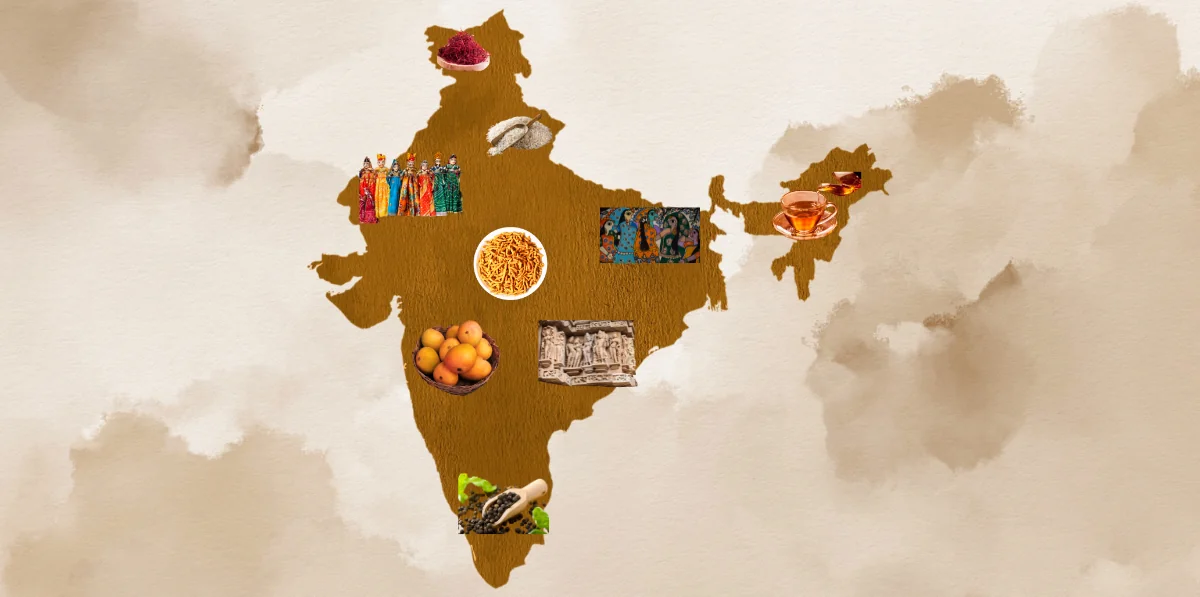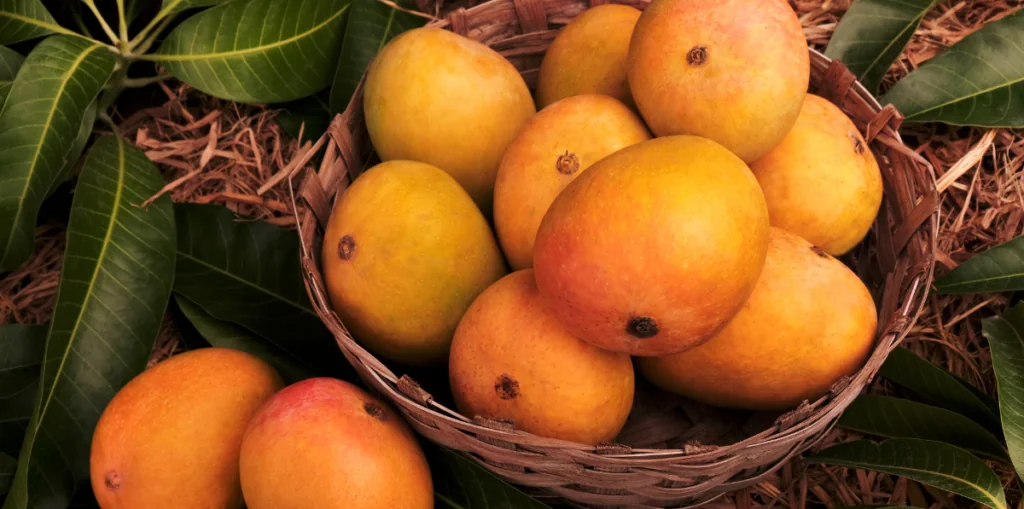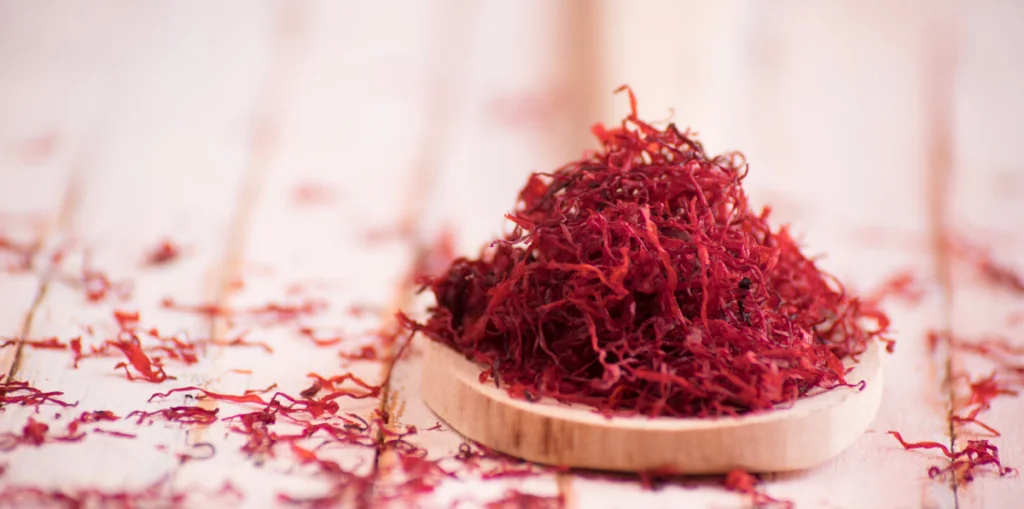
Blog
GI Tags: Reflecting the Rich Culture of India #1

Introduction:
India is a country of diverse cultures and traditions, with a rich heritage of reflected in its unique products. Many of these products are recognized by geographical indication or GI tags, a type of intellectual property that ties the product to its exceptional history, where it is believed that only products produced in a particular region can be sold under that name. Geographic indication prevents the negative effects of these products and encourages the development of regional handicrafts and local businesses. Here, we review some of India’s iconic GI products including Kota Doriya, Alphonso Mango, Kashmiri Saffron, Blue Pottery, Chikankari and Bikaneri Bhujia.
Kota Doriya: The Pride of Rajasthan
Kota Doriya is a fabric from the Kota district of Rajasthan, known for its square check pattern known as ‘khat’. Woven on a traditional loom from a blend of cotton and silk, this delicate fabric is both durable and breathable. The weaving process involves a unique combination of warp and weft, creating a beautiful pattern suitable for the hot and dry climate of Rajasthan. Mughal rulers brought experts from Mysore to Kota. The craft has evolved over the centuries and today Kota Doriya is sought after for its beauty and comfort. GI tag helps maintain the authenticity of modern products by providing recognition and financial security to weavers.
Alphonso Mango: The King of Fruits
The Alphonso mango, also known as Hapus, originates from the coastal region of Ratnagiri in Maharashtra. Known for its tangy flavour, smooth texture and vibrant saffron colour, the Alphonso mango is often referred to as the “King of Fruits.” Its unique taste is due to the special conditions and soil type of the Konkan region where it grows. It is sold in a variety of ways. This not only protects consumers from fake products but also supports local farmers by ensuring fair prices and commercial recognition. The harvest season is eagerly awaited by fruit lovers all over the world, making Alphonso a symbol of India’s agricultural heritage.

Jaipur Blue Pottery: The Art of Glazing
Jaipur blue pottery is a craft of Rajasthan, known for its eye-catching blue and white patterns. This particular type of pottery uses a special technique that uses a mixture of quartz stone powder, glass powder, Multani mitti (fuller earth), borax, gum and water instead of clay. The result is a smooth and shiny surface, which is then hand-painted with intricate floral and geometric patterns. Today, Blue Pottery is highly valued by art lovers around the world.
Lucknow Chikankari: Embroidery Elegance
Lucknow Chikankari is a type of embroidery from Uttar Pradesh, known for its beautiful patterns and designs. Chikankari involves different types of weaving such as shadow work, chain stitch and hemstitch, all done by hand on fine fabrics such as muslin, silk and cotton. The designs often feature floral patterns inspired by Mughal art and architecture. According to legend, Queen Nur Jahan, wife of Emperor Jahangir, was an excellent embroiderer who introduced the Persian embroidery techniques to India. The Geographical Indication of Chikankari, Lucknow, has played an important role in preserving this heritage, ensuring that the craftsmanship and originality of the embroideries are preserved. It also provides a stable income to many artisans including many women.
Kashmiri Saffron: The Golden Spice
Known for its deep red strands and sweet scent, Kashmiri saffron is one of the most expensive saffrons in the world. Grown in the fertile Kashmir valley, this saffron is valued for its high crocin content, which adds intense colour and flavour to dishes. The history of saffron cultivation in Kashmir dates back over 2,500 years and has been an important part of the culture and economy of the region. This recognition also increases saffron farmers’ confidence, promotes sustainable practices and improves their health. Kashmiri saffron is not just a spice but a symbol of the region’s rich and productive agricultural heritage.

Bikaneri Bhujia: The Crunchy Delight
Bikaneri Bhujia is a crunchy and delicious popular snack made from besan (gram flour). Originated from the desert city of Bikaner in the state of Rajasthan. Flavoured with traditional spices, this spicy food has a unique taste and crispy texture that distinguishes it from its counterparts. Its secrets have been passed down through generations of local families. The GI tag of Bikaneri Bhujia ensures that only bhujia produced in Bikaner using this recipe can be sold under this name. This helps protect Bikaneri Bhujia’s name and reputation, strengthens the local economy and provides employment opportunities to thousands of people in the area.
Conclusion
GI marks on products like Kota Doriya, Alphonso Mango, Kashmiri Saffron, Jaipur Blue Pottery, Lucknow Chikankari and Bikaneri Bhujia are more than just a mark of geographical origin(GI tags). These are a testament to India’s rich heritage and beautiful craftsmanship. These labels help preserve knowledge and skills, provide economic benefits to local communities and ensure consumers receive genuine products. By promoting GI products, we not only celebrate India’s diverse heritage but also contribute to the development and prosperity of handicraft and industrial farms.
Check out more such blogs at Souls of India

